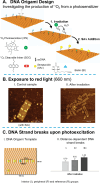Radiation and DNA Origami Nanotechnology: Probing Structural Integrity at the Nanoscale
- PMID: 39473163
- PMCID: PMC11747590
- DOI: 10.1002/cphc.202400863
Radiation and DNA Origami Nanotechnology: Probing Structural Integrity at the Nanoscale
Abstract
DNA nanotechnology has emerged as a groundbreaking field, using DNA as a scaffold to create nanostructures with customizable properties. These DNA nanostructures hold potential across various domains, from biomedicine to studying ionizing radiation-matter interactions at the nanoscale. This review explores how the various types of radiation, covering a spectrum from electrons and photons at sub-excitation energies to ion beams with high-linear energy transfer influence the structural integrity of DNA origami nanostructures. We discuss both direct effects and those mediated by secondary species like low-energy electrons (LEEs) and reactive oxygen species (ROS). Further we discuss the possibilities for applying radiation in modulating and controlling structural changes. Based on experimental insights, we identify current challenges in characterizing the responses of DNA nanostructures to radiation and outline further areas for investigation. This review not only clarifies the complex dynamics between ionizing radiation and DNA origami but also suggests new strategies for designing DNA nanostructures optimized for applications exposed to various qualities of ionizing radiation and their resulting byproducts.
Keywords: DNA damage; DNA structures; Nanostructures; Nanotechnology.
© 2024 The Authors. ChemPhysChem published by Wiley-VCH GmbH.
Conflict of interest statement
The authors declare no conflict of interest.
Figures






References
-
- Rothemund P. W. K., Nature 2006, 440, 297–302. - PubMed
-
- Tapio K., Bald I., Multifunct. Mater. 2020, 3, 032001.
-
- Dey S., Fan C., Gothelf K. V., Li J., Lin C., Liu L., Liu N., Nijenhuis M. A. D., Saccà B., Simmel F. C., Yan H., Zhan P., Nat. Rev. Methods Primers 2021, 1, 1–24.
-
- Hong F., Zhang F., Liu Y., Yan H., Chem Rev 2017, 117, 12584–12640. - PubMed
Publication types
MeSH terms
Substances
Grants and funding
LinkOut - more resources
Full Text Sources

